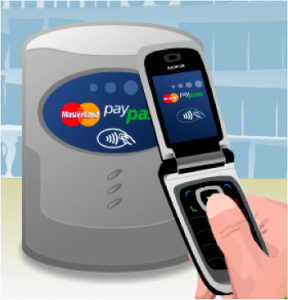
Google’s Gingerbread, the carriers’ mobile payments partnership (Isis), Apple’s recent hire of a seasoned NFC expert: the promise of near field communications (NFC) is finally becoming a reality. Analysts predict rapid acceleration in the next year, with over 40M commercial NFC-enabled devices in the market by the end of 2011.
NFC is a high-frequency, short-range form of radio frequency identification (RFID). NFC chips can be embedded in devices, and are able to both “read” and “write” by communicating over radio frequency. In doing so, NFC enables the so-called “Internet of things” (connectivity within the physical world).
The MIT Enterprise Forum demoed the technology last night using name badges with embedded NFC chips that were read to gain entry to the event using NFC-enabled phones. The technology has far more applications than this simple use case: expect to use your NFC-enabled phone for everything from tapping it on a printer to print a photo, exchanging a file with your colleague, receiving offers from your local grocery store, to finally paying with your phone.
The big takeaway from last night’s event: we are at the “slope of enlightenment” with NFC — primed and ready for developers to begin creating applications.
NFC’s Path to Date
NFC has been around for years, and in fact is used in Japan already for mobile payment and other connectivity. Industry groups have achieved standardization and one phone manufacturer (Nokia) has incorporated the chips into some of their manufactured devices in the last year. The high degree of ease of use around NFC’s connectivity (compared to, say, Bluetooth’s configuration needs) is why so many have invested in NFC as a key technology of the future.
“It has gone very slowly the last five years,” remarked Damien Balsan, Head of NFC Business Development at Nokia, when discussing the over 100 NFC trials and commercial launches that have occurred across the globe. “And now in the last four weeks it is suddenly here, with three major carriers announcing essentially a new payment network and Google announcing their [NFC-enabled] phone.” One analyst firm, Juniper Research, forecasts that 1 in 6 wireless subscribers will have NFC-enabled phones by 2014.

Five years ago industry analysts projected NFC to take flight in mobile phones here in the U.S., and with the killer app discussed mainly being payment. What has hindered this mobile payment from taking off? Device manufacturers didn’t have ample incentive to manufacture the technology into their handsets, and mobile and payment companies couldn’t agree on the business model (banks, payment networks, mobile operators, etc. were all vying for a slice of the revenue pie). What the payment industry was left with was contactless smart card technology, enabling you to “tap and go” your credit card on contactless-enabled point of sale devices at the register, or in closed-loop environments like in transit with the Charlie Card here in Boston.
While the contactless technology described above embeds a passive chip on a plastic card, NFC uses an active chip that when coupled with mobile computing (instead of a dumb card) can deliver far more value added services.
NFC Implementation and Applications
Each person on the panel at the MIT Enterprise Forum represented a different group within the NFC ecosystem, from chip manufacturer to developer to industry group — and all provided examples of how the technology will be integrated in our every day lives moving forward.
NFC has three major use cases or “modes”:
- Card emulation: This is where the chip acts as a unique payment card to enable purchases, offering security and ease of use that many other mobile payments plays do not.
- Peer-to-peer: This is where the chip enables devices – e.g. your phone and home theater center – to connect with one another.
- Reader mode (for content exchange): this is where you use the chip in reader mode to connect with, say, a tag with content on a poster that downloads a movie trailer to your phone or a discount.
“Lots of companies are going to be building things around NFC in the next few years,” Balsan stated. In terms of what the first big killer app will be for NFC, each panelist had their own thoughts.

Brent Bowen of INSIDE Secure (provider of chips) does not believe payment will be the first application. Speaking to the payment industry’s legacy piping, he believes the first killer app will come from retail loyalty or social media. MIT spin-off and semiconductor manufacturer Kovio‘s Vik Pavate believes similarly, remarking hat the killer app will likely be within the $500B advertising industry. Ivan Lazarev who has built his company around NFC applications at events (ITN International), believes the killer app will actually be in the B2B space.
However it was Ville Sointu, an NFC developer at TIETO, who concluded the presentation and offered perhaps the most visionary statement: “There will probably be no one killer app for NFC. It will be kind of like the browser — the ubiquitous way of communicating with the physical world.”
In terms of the current ecosystem around NFC, there is a NFC Patent Pool that allows developer to license intellectual property around NFC. There are also APIs that developers can build to — including the Qt NFC API and Open NFC™, which is an open source project. Each panelist encouraged developers in the audience to reach out to them for access to the APIs.
Analysts project that by 2011, 10 percent of smartphones will ship with NFC capabilities and 30 percent by 2015 (and this projection was made before Google’s announcement). My interest in consumer tech began after studying NFC-enabled mobile payments at a Federal Reserve internship of all places, and after a five-year hiatus, I couldn’t be more excited that the ecosystem surrounding NFC is finally at a place where app development and commercialization can begin.
A big thanks to MIT Enterprise Forum for organizing and hosting the presentation. Make sure you follow them on Twitter @MITefcmb.
